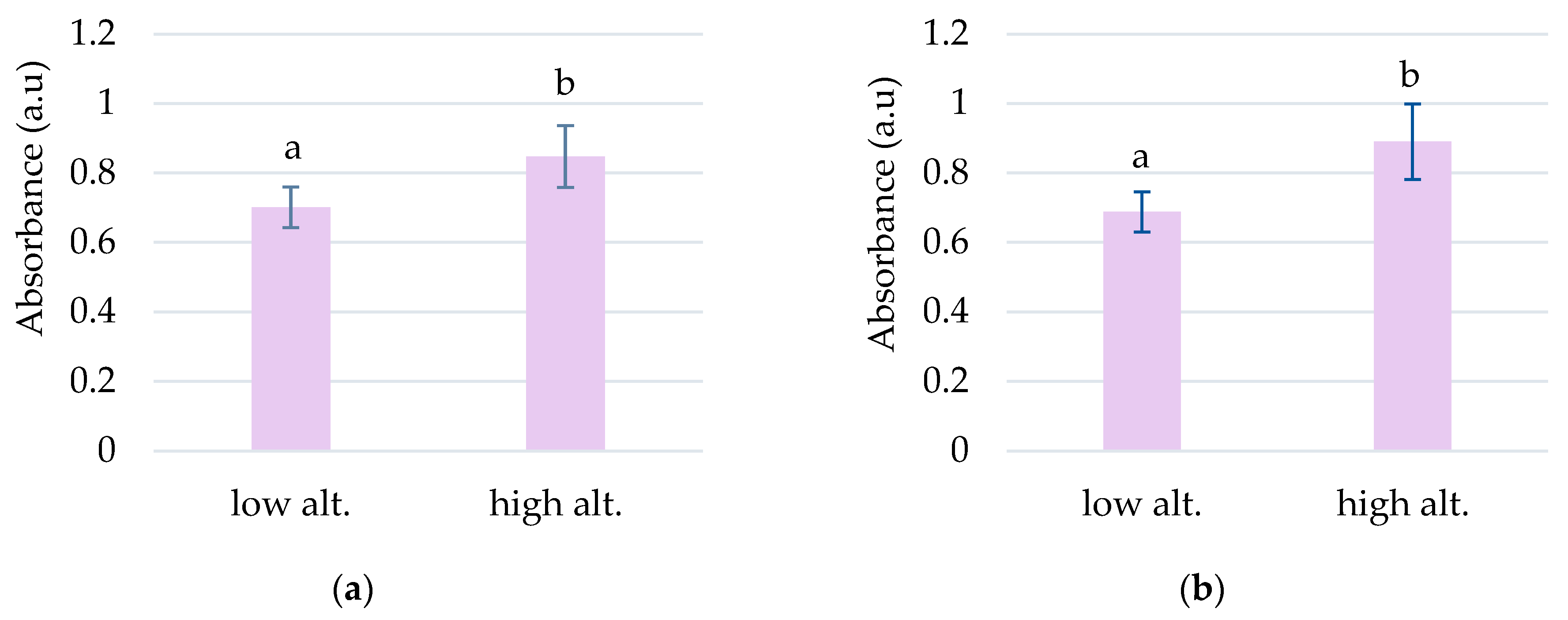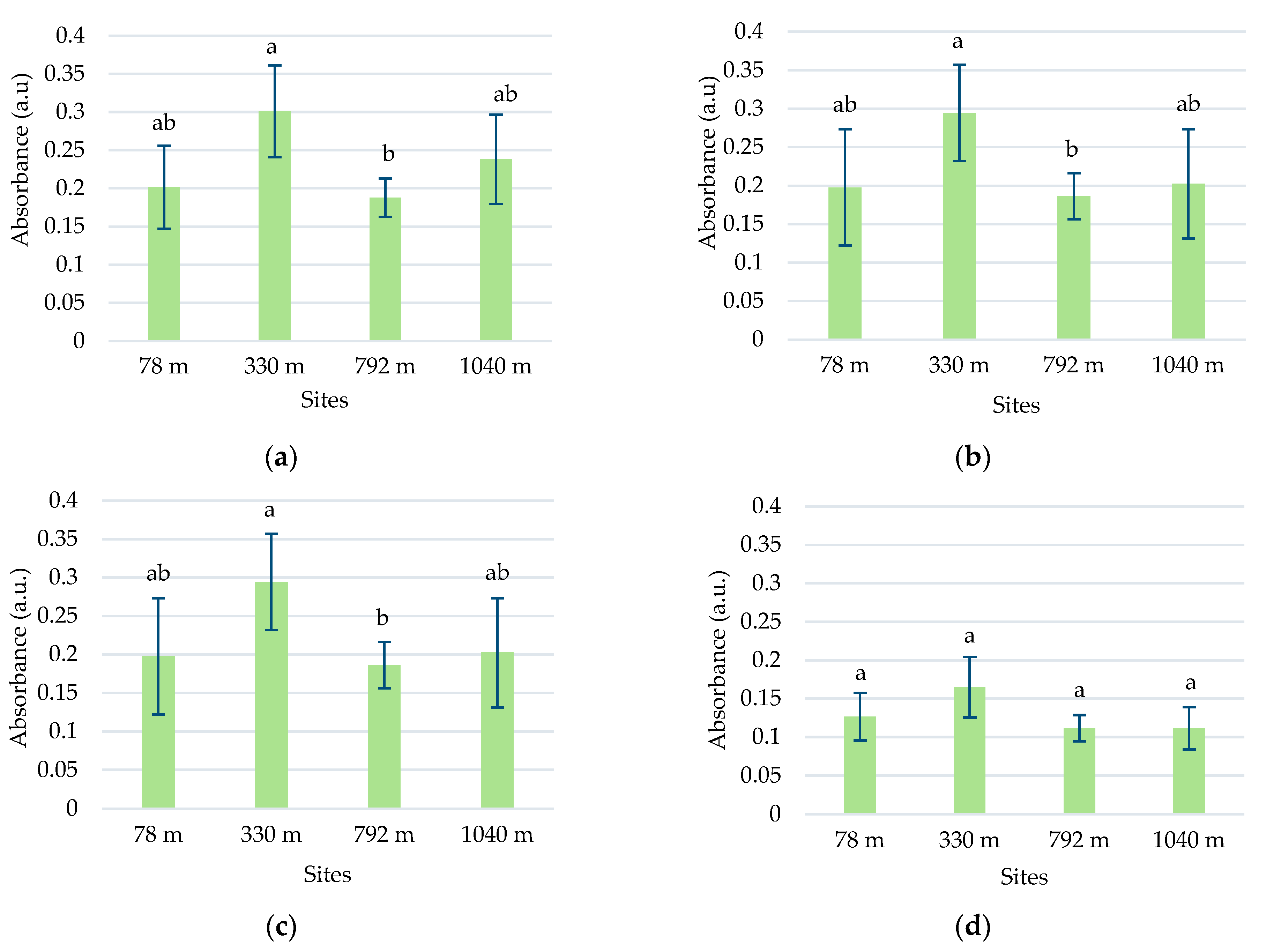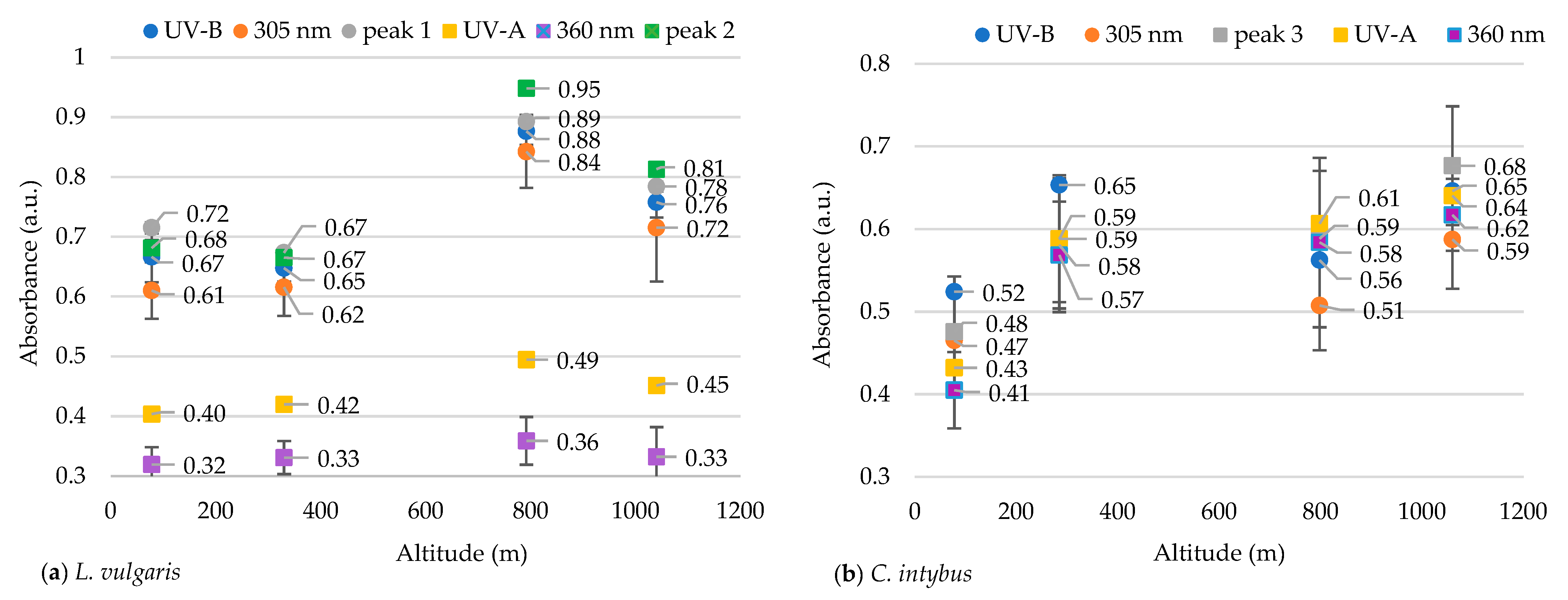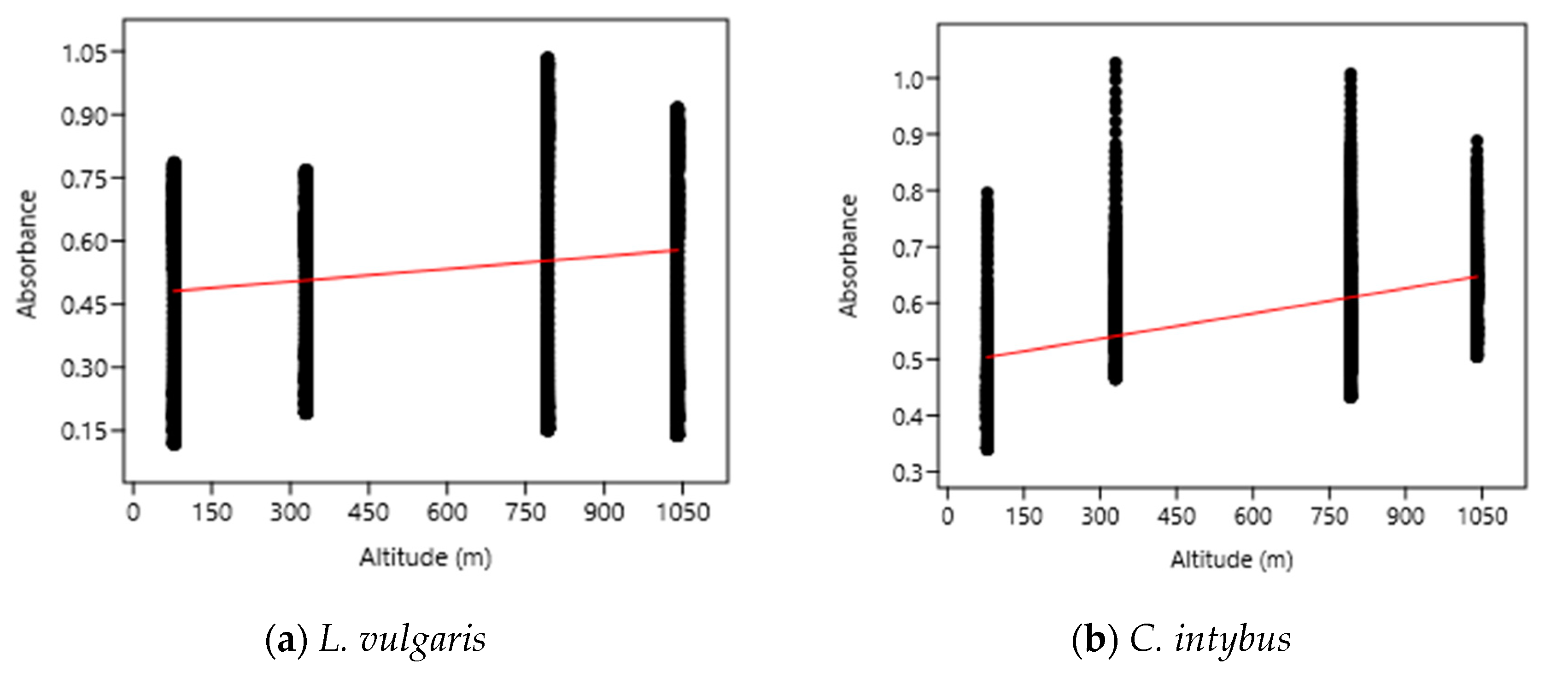Urban Flora Riches: Unraveling Metabolic Variation Along Altitudinal Gradients in Two Spontaneous Plant Species
Abstract
:1. Introduction
2. Results
2.1. Analysis of UV and Visible Absorption Spectra
2.2. Analysis of UV-B and UV-A Absorption Spectra
2.3. Analysis of Fluorometric Spectra with Excitation in UV-B
2.4. Accumulation of Secondary Metabolites on Altitudinal Gradient
2.4.1. Total Polyphenol Content
2.4.2. Total Flavonoid Content
2.4.3. Total Content of Condensed Tannins
2.4.4. Total Triterpene Content
2.4.5. Determination of the Chlorophyll and Carotenoid Pigment Content
3. Discussion
4. Materials and Methods
4.1. Characterization of the Sites Selected for Sampling
4.2. Biological Material
4.3. Methanolic Extract Preparation
4.4. Spectrophotometry and Fluorimetry Analysis
4.5. Calculation of Chlorophyll and Carotenoid Concentrations
4.6. Determination of Total Polyphenol Content
4.7. Determination of Flavonoid Content
4.8. Determination of Condensed Tannin Content
4.9. Determination of Triterpene Content
4.10. Statistical Data Analysis
5. Conclusions
Supplementary Materials
Author Contributions
Funding
Data Availability Statement
Acknowledgments
Conflicts of Interest
References
- Ganzera, M.; Guggenberger, M.; Stuppner, H.; Zidorn, C. Altitudinal Variation of Secondary Metabolite Profiles in Flowering Heads of Matricaria chamomilla cv. BONA. Planta Med. 2008, 74, 453–457. [Google Scholar] [CrossRef]
- Blumthaler, M.; Ambach, W.; Rehwald, W. Solar UV-A and UV-B radiation fluxes at two Alpine stations at different altitudes. Theor. Appl. Climatol. 1992, 46, 39–44. [Google Scholar] [CrossRef]
- Deckmyn, G.; Impens, I. The ratio UV-B/photosynthetically active radiation (PAR) determines the sensitivity of rye to increased UV-B radiation. Environ. Exp. Bot. 1997, 37, 3–12. [Google Scholar] [CrossRef]
- Krizek, D.T. Influence of PAR and UV-A in determining plant sensitivity and photomorphogenic responses to UV-B radiation. Photochem. Photobiol. 2004, 79, 307–315. [Google Scholar] [CrossRef] [PubMed]
- Rozema, J.; Chardonnens, A.; Tosserams, M.; Hafkenscheid, R.; Bruijnzeel, L. Leaf thickness and UV-B absorbing pigments of plants in relation to an elevational gradient along the Blue Mountains, Jamaica. Plant Ecol. 1997, 128, 151–159. [Google Scholar] [CrossRef]
- Sullivan, H.; Teramura, A.H.; Ziska, L.H. Variation in UV-B sensitivity in plants from a 3,000-m elevation gradient in Hawaii. Am. J. Bot. 2015, 79, 737–743. [Google Scholar]
- Rai, K.; Agrawal, S. Effects of UV-B radiation on morphological, physiological and biochemical aspects of plants: An overview. Int. J. Sci. Res. 2017, 6, 87–113. [Google Scholar]
- Baran, M.; Kissabekova, A.; Krasnikov, A.; Tsiumra, V.; Vasylechko, L.; Zazubovich, S.; Zhydachevskyy, Y. Bi3+-doped garnets as possible ultraviolet persistent phosphors. Opt. Mater. 2023, 137, 113584. [Google Scholar] [CrossRef]
- Lavola, A.; Nybakken, L.; Rousi, M.; Pusenius, J.; Petrelius, M.; Kellomäki, S.; Julkunen-Tiitto, R. Combination Treatment of Elevated UV-B Radiation, CO2 and Temperature Has Little Effect on Silver Birch (Betula pendula) Growth and Phytochemistry. Physiol. Plant. 2013, 149, 499–514. [Google Scholar] [CrossRef]
- Sharma, S.; Chatterjee, S.; Kataria, S.; Joshi-Paneri, J.; Datta, S.; Vairale, M.; Veer, V.A. Review on Responses of Plants to UV-B Radiation Related Stress. In UV-B Radiation: From Environmental Stressor to Regulator of Plant Growth; Singh, V.P., Singh, S., Prasad, S.M., Parihar, P., Eds.; Wiley Blackwell: Oxford, UK, 2017; pp. 75–97. [Google Scholar] [CrossRef]
- Milić Komić, S.; Živanović, B.; Dumanović, J.; Kolarž, P.; Sedlarević Zorić, A.; Morina, F.; Vidović, M.; Veljović Jovanović, S. Differential Antioxidant Response to Supplemental UV-B Irradiation and Sunlight in Three Basil Varieties. Int. J. Mol. Sci. 2023, 24, 15350. [Google Scholar] [CrossRef]
- Caldwell, M.M.; Robberecht, R.; Flint, S.D. Internal filters: Prospects for UV-acclimation in higher plants. Physiol. Plant 1983, 58, 445–450. [Google Scholar] [CrossRef]
- Robberecht, R.; Caldwell, M.M.; Billings, W.D. Leaf Ultraviolet Optical Properties Along a Latitudinal Gradient in the Arctic-Alpine Life Zone. Ecology 1980, 61, 612–619. [Google Scholar] [CrossRef]
- Sullivan, J.H.; Teramura, A.H. The effects of ultraviolet-B radiation on loblolly pine. I. Growth, photosynthesis and pigment production in greenhouse-grown seedlings. Physiol. Plant 1989, 77, 202–207. [Google Scholar] [CrossRef]
- Van de Staaij, J.W.M.; Ernst, W.H.O.; Hakvoort, H.W.J.; Rozema, J. Ultraviolet-B (280–320 nm) Absorbing Pigments in the Leaves of Silene vulgaris: Their Role in UV-B Tolerance. J. Plant Physiol. 1995, 147, 75–80. [Google Scholar] [CrossRef]
- Murai, Y.; Takemura, S.; Takeda, K.; Kitajima, J.; Iwashina, T. Altitudinal variation of UV-absorbing compounds in Plantago asiatica. Biochem. Syst. Ecol. 2009, 37, 378–384. [Google Scholar] [CrossRef]
- Liu, Y.; Liu, J.; Abozeid, A.; Wu, K.X.; Guo, X.R.; Mu, L.Q.; Tang, Z.H. UV-B Radiation Largely Promoted the Transformation of Primary Metabolites to Phenols in Astragalus mongholicus Seedlings. Biomolecules 2020, 10, 504. [Google Scholar] [CrossRef] [PubMed]
- Jiang, H.; Li, Y.; He, R.; Tan, J.; Liu, K.; Chen, Y.; Liu, H. Effect of Supplemental UV-A Intensity on Growth and Quality of Kale under Red and Blue Light. Int. J. Mol. Sci. 2022, 23, 6819. [Google Scholar] [CrossRef] [PubMed]
- Lee, J.-H.; Tanaka, S.; Goto, E. Growth and Biosynthesis of Phenolic Compounds of Canola (Brassica napus L.) to Different Ultraviolet (UV)-B Wavelengths in a Plant Factory with Artificial Light. Plants 2022, 11, 1732. [Google Scholar] [CrossRef]
- Qi, J.; Zhang, M.; Lu, C.; Hettenhausen, C.; Tan, Q.; Cao, G.; Zhu, X.; Wu, G.; Wu, J. Ultraviolet-B enhances the resistance of multiple plant species to lepidopteran insect herbivory through the jasmonic acid pathway. Sci. Rep. 2018, 8, 277. [Google Scholar] [CrossRef]
- Drummen, G.P.C. Fluorescent Probes and Fluorescence (Microscopy) Techniques—Illuminating Biological and Biomedical Research. Molecules 2012, 17, 14067–14090. [Google Scholar] [CrossRef]
- Abreu-Velez, A.M.; Calle-Isaza, J.; Howard, M.S. Immunofluorescence Patterns in Selected Dermatoses, Including Blistering Skin Diseases Utilizing Multiple Fluorochromes. N. Am. J. Med. Sci. 2015, 7, 397–402. [Google Scholar] [CrossRef] [PubMed]
- Tario, J.D.; Wallace, P.K. Reagents and Cell Staining for Immunophenotyping by Flow Cytometry. In Pathobiology of Human Disease; McManus, L.M., Mitchell, R.N., Eds.; Academic Press: Oxford, UK, 2014; pp. 3678–3701. ISBN 9780123864574. [Google Scholar] [CrossRef]
- Fioratti, C.A.G.; Falcão, E.A.; da Silva, R.M.; do Carmo Vieira, M.; Caires, A.R.L.; Mussury, R.M. Application of Optical Fluorescence Spectroscopy for Studying Bee Abundance in Tropaeolum majus L. (Tropaeolaceae). Biology 2022, 11, 887. [Google Scholar] [CrossRef]
- Prokopy, R.J.; Owens, E.D. Visual Detection of Plants by Herbivorous Insects. Annu. Rev. Entomol. 1983, 28, 337–364. [Google Scholar] [CrossRef]
- Grasel, F.d.S.; Ferrão, M.F.; Wolf, C.R. Ultraviolet Spectroscopy and Chemometrics for the Identification of Vegetable Tannins. Ind. Crops Prod. 2016, 91, 279–285. [Google Scholar] [CrossRef]
- Barbehenn, R.V.; Constabel, P.C. Tannins in plant–herbivore interactions. Phytochemistry 2011, 72, 1551–1565. [Google Scholar] [CrossRef] [PubMed]
- Tharayil, N.; Suseela, V.; Triebwasser, D.J.; Preston, C.M.; Gerard, P.D.; Dukes, J.S. Changes in the structural composition and reactivity of Acer rubrum leaf litter tannins exposed to warming and altered precipitation: Climatic stress-induced tannins are more reactive. New Phytol. 2011, 191, 132–145. [Google Scholar] [CrossRef] [PubMed]
- Ciocan, A.-G.; Tecuceanu, V.; Enache-Preoteasa, C.; Mitoi, E.M.; Helepciuc, F.E.; Dimov, T.V.; Simon-Gruita, A.; Cogălniceanu, G.C. Phenological and Environmental Factors’ Impact on Secondary Metabolites in Medicinal Plant Cotinus coggygria Scop. Plants 2023, 12, 1762. [Google Scholar] [CrossRef]
- Gil, M.; Pontin, M.; Berli, F.; Bottini, R.; Piccoli, P. Metabolism of Terpenes in the Response of Grape (Vitis vinifera L.) Leaf Tissues to UV-B Radiation. Phytochemistry 2012, 77, 89–98. [Google Scholar] [CrossRef]
- Kubo, I.; Nakanishi, K. Some Terpenoid Insect Antifeedants from Tropical Plants. In Synthesis of Pesticides: Chemical Structure and Biological Activity of Natural Products with Biological Activity; Geissbühler, H., Ed.; Pergamon: Oxford, UK, 1979; pp. 284–294. ISBN 9780080223490. [Google Scholar] [CrossRef]
- González-Coloma, A.; López-Balboa, C.; Santana, O.; Reina, M.; Fraga, B.M. Triterpene-Based Plant Defenses. Phytochem. Rev. 2011, 10, 245–260. [Google Scholar] [CrossRef]
- Boncan, D.A.T.; Tsang, S.S.K.; Li, C.; Lee, I.H.T.; Lam, H.-M.; Chan, T.-F.; Hui, J.H.L. Terpenes and Terpenoids in Plants: Interactions with Environment and Insects. Int. J. Mol. Sci. 2020, 21, 7382. [Google Scholar] [CrossRef]
- Piccini, C.; Cai, G.; Dias, M.C.; Romi, M.; Longo, R.; Cantini, C. UV-B Radiation Affects Photosynthesis-Related Processes of Two Italian Olea europaea (L.) Varieties Differently. Plants 2020, 9, 1712. [Google Scholar] [CrossRef]
- Badmus, U.O.; Crestani, G.; Cunningham, N.; Havaux, M.; Urban, O.; Jansen, M.A.K. UV Radiation Induces Specific Changes in the Carotenoid Profile of Arabidopsis thaliana. Biomolecules 2022, 12, 1879. [Google Scholar] [CrossRef]
- Euro+Med PlantBase. Available online: http://www.europlusmed.org (accessed on 7 December 2023).
- Angiosperm Phylogeny Website. Available online: http://www.mobot.org/mobot/research/apweb/welcome.html (accessed on 15 July 2023).
- Jachuła, J.; Konarska, A.; Denisow, B. Micromorphological and Histochemical Attributes of Flowers and Floral Reward in Linaria vulgaris (Plantaginaceae). Protoplasma 2018, 255, 1763–1776. [Google Scholar] [CrossRef]
- Ward, S.M.; Fleischmann, C.E.; Turner, M.F.; Sing, S.E. Hybridization between Invasive Populations of Dalmatian Toadflax (Linaria dalmatica) and Yellow Toadflax (Linaria vulgaris). Invasive Plant Sci. Manag. 2009, 2, 369–378. [Google Scholar] [CrossRef]
- Ciocârlan, V. Flora ilustrată a României (Pteridophyta et Spermatophyta); Editura Ceres: Bucharest, Romania, 2009; p. 1141. [Google Scholar]
- Kalloo, G. Chicory: Cichorium intybus L. In Genetic Improvement of Vegetable Crops; Kalloo, G., Bergh, B.O., Eds.; Pergamon: Amsterdam, The Netherlands, 1993; pp. 535–540. [Google Scholar] [CrossRef]
- Tunçtürk, M.; Tunçtürk, R.; Eryiğit, T.; Nohutcu, L. Some Chemical Compounds of Cichorium intybus L. Species Distributed in Van Region. J. Pharm. Res. 2018, 17, 83–87. [Google Scholar]
- Li, X.; Ke, X.; Zhou, H.; Tang, Y. Contrasting Altitudinal Patterns of Leaf UV Reflectance and Absorbance in Four Herbaceous Species on the Qinghai–Tibetan Plateau. J. Plant Ecol. 2019, 12, 245–254. [Google Scholar] [CrossRef]
- Searles, P.S.; Flint, S.D.; Caldwell, M.M. A meta-analysis of plant field studies simulating stratospheric ozone depletion. Oecologia 2001, 127, 1–10. [Google Scholar] [CrossRef] [PubMed]
- Del Valle, J.C.; Buide, M.L.; Whittall, J.B.; Valladares, F.; Narbona, E. UV Radiation Increases Phenolic Compound Protection but Decreases Reproduction in Silene littorea. PLoS ONE 2020, 153, e0231611. [Google Scholar] [CrossRef] [PubMed]
- Lenk, S.; Buschmann, C. Distribution of UV-Shielding of the Epidermis of Sun and Shade Leaves of the Beech (Fagus sylvatica L.) as Monitored by Multi-Colour Fluorescence Imaging. J. Plant Physiol. 2006, 163, 1273–1283. [Google Scholar] [CrossRef] [PubMed]
- Boyarskikh, I.G.; Artemov, I.A.; Kuznetsov, A.A.; Kostikova, V.A. Changes in Profiles of Classes and of Individual Polyphenols in Leaves of Spiraea chamaedryfolia and Spiraea media along an Altitudinal Gradient. Plants 2023, 12, 2977. [Google Scholar] [CrossRef] [PubMed]
- Sharaf, A.E.-M.A.; Khafagi, O.; Hatab, E.; Moursy, M. Effect of altitudinal gradients on the content of carbohydrate, protein, proline and total phenols of some desert plants in Saint Katherine Mountain, South Sinai, Egypt. Middle East J. Sci. Res. 2013, 14, 122–129. [Google Scholar]
- Murai, Y.; Setoguchi, H.; Kitajima, J.; Iwashina, T. Altitudinal Variation of Flavonoid Content in the Leaves of Fallopia japonica and the Needles of Larix kaempferi on Mt. Fuji. Nat. Prod. Commun. 2015, 10, 407–411. [Google Scholar] [CrossRef]
- Dong, T.; Sha, Y.; Liu, H.; Sun, L. Altitudinal Variation of Metabolites, Mineral Elements and Antioxidant Activities of Rhodiola crenulata (Hook.f. & Thomson) H. Ohba. Molecules 2021, 26, 7383. [Google Scholar] [CrossRef] [PubMed]
- Bernal, M.; Llorens, L.; Julkunen-Tiitto, R.; Badosa, J.; Verdaguer, D. Altitudinal and Seasonal Changes of Phenolic Compounds in Buxus sempervirens Leaves and Cuticles. Plant Physiol. Biochem. 2013, 70, 471–482. [Google Scholar] [CrossRef]
- Zhou, S.; Yan, X.; Yang, J.; Qian, C.; Yin, X.; Fan, X.; Fang, T.; Gao, Y.; Chang, Y.; Liu, W.; et al. Variations in Flavonoid Metabolites Along Altitudinal Gradient in a Desert Medicinal Plant Agriophyllum squarrosum. Front. Plant Sci. 2021, 12, 683265. [Google Scholar] [CrossRef] [PubMed]
- Erelli, M.; Ayres, M.; Eaton, G. Altitudinal Patterns in Host Suitability for Forest Insects. Oecologia 1998, 117, 133–142. [Google Scholar] [CrossRef]
- Asplund, J.; van Zuijlen, K.; Roos, R.E.; Birkemoe, T.; Klanderud, K.; Lang, S.I.; Wardle, D.A.; Nybakken, L. Contrasting Responses of Plant and Lichen Carbon-Based Secondary Compounds across an Elevational Gradient. Funct. Ecol. 2021, 35, 330–341. [Google Scholar] [CrossRef]
- Alonso-Amelot, M.E.; Oliveros-Bastidas, A. Phenolics and Condensed Tannins of High Altitude Pteridium arachnoideum in Relation to Sunlight Exposure, Elevation, and Rain Regime. Biochem. Syst. Ecol. 2007, 35, 1–10. [Google Scholar] [CrossRef]
- Alonso-Amelot, M.E.; Oliveros, A.; Calcagno-Pisarelli, M.P. Phenolics and condensed tannins in relation to altitude in neotropical Pteridium spp: A field study in the Venezuelan Andes. Biochem. Syst. Ecol. 2004, 32, 969–981. [Google Scholar] [CrossRef]
- Sun, C.; Shang, X.; Ding, H.; Cao, Y.; Fang, S. Natural variations in flavonoids and triterpenoids of Cyclocarya paliurus leaves. J. For. Res. 2021, 32, 805–814. [Google Scholar] [CrossRef]
- Orasul Magurele. Available online: https://primariamagurele.ro/statistici (accessed on 7 December 2023).
- Despre Oras. Available online: https://www.primariabaicoi.ro/despre-oras (accessed on 7 December 2023).
- Date Geografice. Available online: https://www.primaria-sinaia.ro/date-geografice/ (accessed on 7 December 2023).
- Cadrul Geographic. Available online: https://www.primaria-predeal.ro/cadrul-geografic/ (accessed on 7 December 2023).
- RoBioAtlas. Romanian Atlas Web App for Biology—Open Access. 2023. Available online: https://www.teon.ro/robioatlas/index.html (accessed on 8 October 2023).
- OGIMET. Available online: https://www.ogimet.com (accessed on 2 September 2023).
- Atmosphere Data Store. Copernicus Atmosphere Monitoring Service. Available online: https://ads.atmosphere.copernicus.eu/cdsapp#!/home (accessed on 2 September 2023).
- Van Geffen, J.; Van Weele, M.; Allaart, M.; Van der A, R. TEMIS UV Index and UV Dose Operational Data Products, Version 2. Dataset. Royal Netherlands Meteorological Institute (KNMI), KNMI/ESA. 2017. Available online: https://www.temis.nl/ (accessed on 2 September 2023). [CrossRef]
- Florea, N.; Ana Conea, A.; Munteanu, I. Soil Map Romania 1:500000. 1976. Available online: https://esdac.jrc.ec.europa.eu/content/soil-map-romania-harta-pedologica-0 (accessed on 11 December 2023).
- Microsoft Corporation. Microsoft Excel (Version 2016), Microsoft: Redmond, WA, USA, 2016.
- Lichtenthaler, H.K. Chlorophylls and Carotenoids: Pigments of Photosynthetic Biomembranes. In Methods in Enzymology; Academic Press: Orlando, FL, USA, 1987; Volume 148, pp. 350–382. [Google Scholar] [CrossRef]
- Mihailović, V.; Matić, S.; Mišić, D.; Solujić, S.; Stanić, S.; Katanić, J.; Stanković, N. Chemical composition, antioxidant and antigenotoxic activities of different fractions of Gentiana asclepiadea L. roots extract. EXCLI J. 2013, 12, 807–823. [Google Scholar] [PubMed]
- Zhishen, J.; Mengcheng, T.; Jianming, W. The determination of flavonoid content in mulberry and their scavenging effects on superoxide radicals. Food Chem. 1999, 64, 555–559. [Google Scholar] [CrossRef]
- Sun, B.J.M.; Ricardo-da-Silva, I.; Spranger, C. Critical factors of vanillin assay for catechins and proanthocyanidins. J. Agric. Food Chem. 1998, 46, 4267–4274. [Google Scholar] [CrossRef]
- Ke, Z.C.; Zhu, Z.P.; Xu, Z.Y.; Fang, C.; Hu, S.Q. Response surface optimized extraction of total triterpene acids from Eriobotrya japonica (Thunb) Lindl (Loquat) leaf and evaluation of their in vitro antioxidant activities. Trop. J. Pharm. Res. 2014, 13, 787–792. [Google Scholar] [CrossRef]
- Hammer, O.; Harper, D.; Ryan, P. PAST: Paleontological Statistics Software Package for Education and Data Analysis. Palaeontol. Electron. 2001, 4, 1–9. [Google Scholar]










| Wavelength Range | Peak No. | The Maximum Absorption Intervals for Each Peak (nm) | |
|---|---|---|---|
| L. vulgaris | C. intybus | ||
| UV-B (280–320 nm) | 1 | 283–293 | |
| UV-A (320–400 nm) | 2 | 316–325 | |
| 3 | 333–342 | ||
| 4 | 378–381 | ||
| Visible (400–750 nm) | 5 | 414–422 | 424–430 |
| 6 | 437–446 | ||
| 7 | 469–476 | 464–472 | |
| 8 | 536–539 | ||
| 9 | 616–618 | 616–620 | |
| 10 | 666–672 | 664–668 | |
| Species | Altitude (m) | |||
|---|---|---|---|---|
| 78 | 330 | 792 | 1040 | |
| L. vulgaris | 1.911 | 1.860 | 2.347 | 2.151 |
| C. intybus | 1.148 | 1.021 | 0.869 | 0.951 |
Disclaimer/Publisher’s Note: The statements, opinions and data contained in all publications are solely those of the individual author(s) and contributor(s) and not of MDPI and/or the editor(s). MDPI and/or the editor(s) disclaim responsibility for any injury to people or property resulting from any ideas, methods, instructions or products referred to in the content. |
© 2024 by the authors. Licensee MDPI, Basel, Switzerland. This article is an open access article distributed under the terms and conditions of the Creative Commons Attribution (CC BY) license (https://creativecommons.org/licenses/by/4.0/).
Share and Cite
Mogîldea, E.D.; Mitoi, M.E.; Biță-Nicolae, C.; Murariu, D. Urban Flora Riches: Unraveling Metabolic Variation Along Altitudinal Gradients in Two Spontaneous Plant Species. Plants 2024, 13, 657. https://doi.org/10.3390/plants13050657
Mogîldea ED, Mitoi ME, Biță-Nicolae C, Murariu D. Urban Flora Riches: Unraveling Metabolic Variation Along Altitudinal Gradients in Two Spontaneous Plant Species. Plants. 2024; 13(5):657. https://doi.org/10.3390/plants13050657
Chicago/Turabian StyleMogîldea, Elena Daniela, Monica Elena Mitoi, Claudia Biță-Nicolae, and Dumitru Murariu. 2024. "Urban Flora Riches: Unraveling Metabolic Variation Along Altitudinal Gradients in Two Spontaneous Plant Species" Plants 13, no. 5: 657. https://doi.org/10.3390/plants13050657







